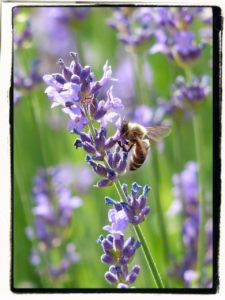
Botanical: Lavandula angustifolia
Table of Contents
Family: Lamiaceae
parts used: flowering buds
energetics: cooling (Used for cooling to hot conditions, such as inflammation, spasm, pain, and infection. Cools an overheated liver and stabilizes the heart) [1]
actions: analgesic, anti-convulsive, anti-depressant, anti-inflammatory, anti-microbial, anti-spasmodic, anti-viral, carminative, cholagogue, diuretic, hypotensive, insecticidal, nervine, parasiticidal, rubefacient, restorative, sedative, sudorfic, tonic, vermifugal, vulnerary
The herb we grow is “Munstead”, an English lavender.
I was not impressed at all with lavender for a very long time. I just couldn’t get past the smell that everyone raved on about. It was not appealing to me in the least, Everything from laundry soap to elegant home-made muffins had lavender in it. Hmmmm. Then I started reading.
It was Hannah that first mentioned that we should be harvesting it. We had a small patch growing, I mean, every herb farm should have some, everyone knows that. It is a beautiful plant and the flowers are a spectacular color of purple. So she started harvesting, processing, and using it in everything. Now, I’m sold, still not on the smell, it’s not everyone’s cup of tea, but it is a powerfully effective herb for many, many things.
Culinary Uses for Lavender
Lavender is one of the herbs often used in the famous herb mix called “Herbs de Provence”.
This plant’s fragrance is very strong and a little goes a long way. One full tablespoon of this dried herb can make a full pot of tea depending on your taste. You will just have to brew your own until you figure out how strong you like it. Steep tea only around 5-10 minutes.

Using Lavender for Wellness
Queen Elizabeth l of England used to drink lavender tea to fight tension headaches. [3]
- headaches – Drink tea and/or use as a compress on forehead (good mixed with basil)
- upset stomach, nausea and gas
- emotional support to ease depression4
- calm and lift spirits
- insomnia – promotes natural sleep
- soothe insect bites & stings
- fungal infections
- tonic for general health
- helps wounds heal faster
- eases aches from rheumatism
- relief for minor burns and sunburns
External Use of Lavender
Lavender Compress To use in a compress, make a strong tea and soak a cotton towel in it. While still warm (not hot) apply to the part of the body needed. Leave in place until completely cooled.
A compress to the forehead can provide relief for:
- headaches
- congestion
- fatigue
- tension
- sadness
- hangovers
Use a lavender compress on other body parts to treat minor burns, aches & pains, minor wounds and even acne.
There are many ways to use lavender in the bath:
- Fill a muslin bag with dried or fresh herb and let the water run over it as your tub fills.
- Make a strong infusion by steeping a large handful in a quart or more of hot water and let it steep for a couple hours. Strain and pour into bath water.
- Add 5 to 10 drops of pure lavender essential oil to a full bath or add the essential oil to your bath salts.
The essential oil is an excellent aid for burns. [2] To sooth sunburns or other burns, add a few drops of the essential oil to a bottle of cool water and shake (always shake essential oil mixed with water before spraying, oil and water do not stay mixed) spray on the sunburn. It offers quick relief. If you have fresh or dried, make a strong infusion and put it straight into a spray bottle, use the same way.
Lavender essential oil is a well known “go to” for anxiety and stress. Why do you suppose so many bath soaks and steams contain lavender? If you’d like to know more about lavender’s stress reducing properties, see How Essential Oils Can Help Combat Anxiety and Stress.
Dosage Suggestions: 1 teaspoon of dried lavender buds in 8 ounces of water (steep for 20-30 minutes and drink 4 ounces 3x/day); 1.5-2 mL 3x/day of a 1:5 tincture
*All doses come from the book Herbal Therapy and Supplements by David Winston and Merrily A. Kuhn.
Safety:
- The German Commission E Monographs list no contraindications, side effects, or drug interactions for lavender flower.
References:
- Mojay, G. (1997). Aromatherapy for Healing the Spirit. Rochester, VT: Healing Arts Press.
- Julia Lawless, The Illustrated Encyclopedia of Essential Oils (Rockport, MA: Element Books, 1995), 56-67.
- Denise. “http://teainengland.com/2012/08/fit-for-a-queen-lavender-tea/” Fit for a Queen: Lavender Tea.. Accessed August 22, 2015.
- Jeremy Appleton, ND, Lavender Oil for Anxiety and Depression | Natural Medicine Journal. http://www.naturalmedicinejournal.com/journal/2012-02/lavender-oil-anxiety-and-depression-0. Updated June 08, 2017.








